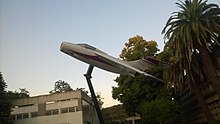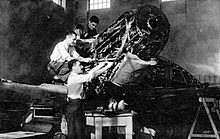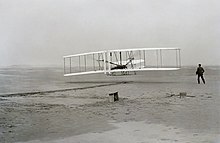Aerospace engineering
Aerospace engineering is a branch of engineering that studies aircraft; encompasses the fields of current aeronautical engineering, related to the design of systems that fly in the atmosphere, and astronautical engineering, understanding the latter as that which deals with the design of propelling vehicles and artifacts that will be placed in the outer space. While aeronautical engineering was the original term, the broader term "aerospace" has superseded it in usage.
Aerospace engineering consists of the application of technology to the design, construction or manufacture and use of devices capable of flying or aerodynamics —mainly airplanes or aircraft, missiles and space equipment— and in the technical and scientific aspects of navigation aircraft and the instruments used by it.
Aerospace engineering deals with designing and building the aerostructures of airplanes and helicopters taking into consideration the laws of aerodynamics, the fundamentals of fluid mechanics and structural engineering. They are also in charge of the integration of the motor elements (alternative, turbofans, turbojets and turboshafts) in the aerostructures to build the aircraft. Other fields of activity of aeronautical engineers are the construction of airports, the design and operation of aeronautical transport networks and the manufacture of special equipment and materials such as weapons, satellites or space rockets which will later be sent on reconnaissance missions abroad. our planet.
Summary
Flight vehicles are subjected to demanding conditions such as those caused by changes in atmospheric pressure and temperature, with structural loading applied to vehicle components. Consequently, they are often products of various technological and engineering disciplines, including aerodynamics, air propulsion, avionics, materials science, structural analysis, and manufacturing. The interaction between these technologies is known as aerospace engineering. Due to the complexity and number of disciplines involved, aerospace engineering is carried out by teams of engineers, each with their own specialized area of expertise.
History
The origins of aerospace engineering can be traced back to the aviation pioneers of the late 19th and early 20th centuries, although the work of Sir George Cayley dates from the last decade of the 18th century to the mid-19th century. One of the most important people in the history of aeronautics and a pioneer in aeronautical engineering, Cayley is credited as the first person to separate the forces of lift and drag, which affect any atmospheric flight vehicle.
Early knowledge of aeronautical engineering was largely empirical, with some concepts and skills imported from other branches of engineering. Some key elements, such as fluid dynamics, were understood by 18th-century scientists.
In December 1903, the Wright Brothers made the first sustained and controlled flight of a powered heavier-than-air aircraft, with a duration of 12 seconds. The 1910s saw the development of aeronautical engineering through the design of World War I military aircraft.
Between World War I and World War II, great advances were made in this field, accelerated by the advent of conventional civil aviation. Notable aircraft from this era include the Curtiss JN 4, the Farman F.60 Goliath, and the Fokker Trimotor. Notable military aircraft from this period include the Mitsubishi A6M Zero, Supermarine Spitfire, and Messerschmitt Bf 109 from Japan, the United Kingdom, and Germany respectively. A significant development in aerospace engineering came with the first operational jet engine powered aircraft, the Messerschmitt Me 262, which entered service in 1944 towards the end of World War II.
The first definition of aerospace engineering appeared in February 1958, considering Earth's atmosphere and outer space as a single realm, thus encompassing both "aerospace" such as spacecraft under the recently coined term "aerospace".
In response to the USSR launching the first satellite, Sputnik, into space on October 4, 1957, American aerospace engineers launched the first American satellite on January 31, 1958. The National Aeronautics and Space Administration was founded in 1958 as a response to the Cold War. In 1969, Apollo 11, the first human space mission to the moon, took place. He saw three astronauts go into orbit around the Moon, with two, Neil Armstrong and Buzz Aldrin, visiting the lunar surface. The third astronaut, Michael Collins, remained in orbit to meet Armstrong and Aldrin after their visit.
A major innovation occurred on January 30, 1970, when the Boeing 747 made its first commercial flight from New York to London. This aircraft made history and became known as the "Jumbo Jet" or "Whale" due to its capacity to hold up to 480 passengers.
Another significant development in aerospace engineering occurred in 1976, with the development of the first supersonic airliner, the Concorde. The development of this aircraft was agreed between the French and the British on November 29, 1962.
On December 21, 1988, the Antonov An-225 Mriya cargo plane began its maiden flight. It holds the records for the world's heaviest aircraft, heaviest airborne cargo, and longest airborne cargo, and has the widest wingspan of any aircraft in operational service.
On October 25, 2007, the Airbus A380 made its first commercial flight from Singapore to Sydney, Australia. This aircraft was the first airliner to surpass the Boeing 747 in terms of passenger capacity, with a maximum of 853. Although development of this aircraft began in 1988 as a competitor to the 747, the A380 made its first test flight in April from 2005.
Profession
An aerospace engineer is in charge of calculating, designing, projecting, optimizing and modifying equipment and mechanical systems used by the aeronautical and space industry, including their production or manufacturing processes, as well as evaluating, planning, directing, optimizing and executing projects engineering in a multidisciplinary context.
Some of the elements that apply to this career are:
- Mechanical engineering: studies the processes of manufactures, maintenance and design of aircraft.
- Astrodynamics: It is the science that studies the behavior of objects, natural and artificial, in space.
- Aerodynamics: It is the study of fluid movement around the wings or other objects, or through wind tunnels (see also sustainability and aeronautics)
- Propulsion - It is the energy necessary to transfer a vehicle through the air, or for the outer space. It is generated by combustion engines (using different mixtures of substances such as gasoline, oxygen and hydrogen) both in reaction and alternative.
- Structure: It is the study of the design of the physical configuration of the ship to support the forces found in the flight. It is usually sought to maintain the lightest weight possible for better performance.
- Material engineering: It deals with the materials with which the aerospace structures are constructed. Develop new materials and modify existing materials to adapt their properties to a specific application.
- Aeroelasticity - the interaction of aerodynamic forces and structural flexibility, potentially causing agitations, separations, etc.
- Airports: infrastructures that define the flight track, platform, control towers, terminal buildings and air navigation aids, as well as their management and coordination with the rest of the services involved as fuel, handlingoperations, firefighters, security and maintenance.
- Computer - specifically concerns the design and programming of any computer system on board an aircraft or spacecraft and the simulation of systems.
The foundation of most of these elements is in theoretical mathematics, such as fluid dynamics for aerodynamics or equations of motion for flight dynamics. But there is also a large empirical component. In history, this empirical component was derived from tests with scale models and prototypes, whether in wind tunnels or in free atmospheres. More recently, advances in computing have allowed the use of computerized fluid dynamics to simulate fluid behavior, reducing the time and expense of wind tunnel testing.
In addition, aerospace engineering pays attention to the integration of all the components that constitute an aeronautical vehicle (subsystems that include power, communications, thermal control, life maintenance, etc.) and its life cycle (design, temperature, pressure, radiation, speed, and useful life), thus encountering extraordinary challenges and specific solutions in the systems domain of aerospace engineering.
Educational centers
In popular culture
The term "rocket scientist" it is sometimes used to describe a person of high intelligence since rocket science is considered a practice that requires great mental ability, especially technical and mathematical. The term is used ironically in the English expression "It's not rocket science" to indicate that a task is simple. Strictly speaking, the use of "science" in "rocket science" is a misnomer since science is about understanding the origins, nature, and behavior of the universe; engineering is about the use of scientific and engineering principles to solve problems and develop new technologies. The most etymologically correct version of this phrase would be "rocket engineer". However, "science" and "engineering" they are often incorrectly used as synonyms.
Contenido relacionado
Space Shuttle Thermal Protection System
Standard (technology)
Pantography





